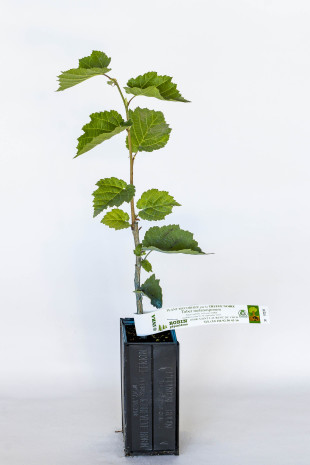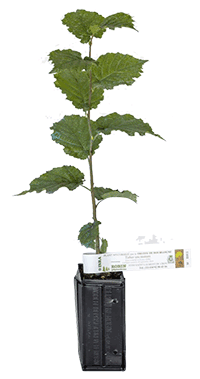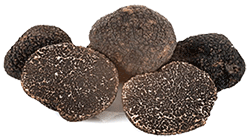


 Young truffle hazelnut plant (Corylus avellana) mycorhized with tuber melanosporum. Hazelnut intended for the production of black truffles. Truffle hornbeam plant aged from 1 to 3 years, produced in France with certified quality under INRAE control.
Young truffle hazelnut plant (Corylus avellana) mycorhized with tuber melanosporum. Hazelnut intended for the production of black truffles. Truffle hornbeam plant aged from 1 to 3 years, produced in France with certified quality under INRAE control.
You wish to diversify your truffle field and try to grow the black truffle? Are you looking for plants likely to produce this famous "Black Diamond" with its inimitable flavor, the jewel of gastronomic meals? Because of its remarkable truffle-growing abilities, the common hazel tree could be the ideal truffle plant to add to your truffle orchard !
 This common hazel truffle plant is obtained after controlled and certified mycorrhization of a common hazel tree (Corylus avellana) with Black truffle spores (Tuber melanosporum). The tree obtained is ready to be planted in your truffle field. It will produce its first truffles within 4 to 5 years.
This common hazel truffle plant is obtained after controlled and certified mycorrhization of a common hazel tree (Corylus avellana) with Black truffle spores (Tuber melanosporum). The tree obtained is ready to be planted in your truffle field. It will produce its first truffles within 4 to 5 years.
In order to meet your expectations, our common hazel truffle plants, mycorhized with the black truffle, are available in 4 sizes of cups:
- in anti-chignon® R430 cup of 0.43 liters
- in anti-chignon® R600 cup of 0.6 liters
- in anti-chignon® R1.5L cup of 1.5 liters
- in R3L container (volume of 3 liters)
Hardy (up to -25°C) and very vigorous, the common hazelnut (Corylus avellana) is an excellent truffle plant as long as it is planted in a very calcareous soil (pH higher than 7.5) and well drained to avoid excess humidity. It can grow in almost all climates, but is particularly suited to dry regions where rain is rare, except in the Mediterranean basin. A fast-growing perennial shrub, the common hazelnut tree can easily establish itself up to the mountains (1700 m) on well exposed slopes (sun to half-shade). Its only requirement is its liveliness, which requires regular pruning (every 2 to 3 years) to ensure good light between the branches. Finally, let us note that the hazelnut tree has the advantage of producing a double harvest. It is indeed the only fruit and truffle plant since it produces truffles in addition to its nuts.
 A true "black diamond", Tuber melanosporum is as rare as it is sought after. It can be recognized by its rounded shape, sometimes bumpy, and its black flesh marbled with white. This truffle gives off an intense perfume and reveals fine aromas that make it an exceptional mushroom. Emblematic of French gastronomy, the black truffle can be eaten cooked or raw, as a seasoning or as an accompaniment to a dish. Black truffles are harvested from November to early March. Depending on the age of the plant and the land chosen, you will have to wait between 6 and 8 years to harvest your first black truffles (reduced to 4 or 5 years in the case of production from hazelnut plants).
A true "black diamond", Tuber melanosporum is as rare as it is sought after. It can be recognized by its rounded shape, sometimes bumpy, and its black flesh marbled with white. This truffle gives off an intense perfume and reveals fine aromas that make it an exceptional mushroom. Emblematic of French gastronomy, the black truffle can be eaten cooked or raw, as a seasoning or as an accompaniment to a dish. Black truffles are harvested from November to early March. Depending on the age of the plant and the land chosen, you will have to wait between 6 and 8 years to harvest your first black truffles (reduced to 4 or 5 years in the case of production from hazelnut plants).
Our truffle hazel plants are produced in our laboratories under the control and license of INRAE. These plants are then pampered for many months in our nurseries. Quality plants, carefully selected, it is the guarantee to obtain a good yield after only a few years.
 The plants raised in ROBIN ANTI-CHIGNON® buckets are subject to a guarantee of recovery in the event of failure to recover more than 20% of the plants delivered. Under this guarantee, the seller undertakes to replace free of charge the defective plants during the season following the actual observation by the seller of the defective delivered plants.
The plants raised in ROBIN ANTI-CHIGNON® buckets are subject to a guarantee of recovery in the event of failure to recover more than 20% of the plants delivered. Under this guarantee, the seller undertakes to replace free of charge the defective plants during the season following the actual observation by the seller of the defective delivered plants.